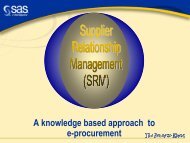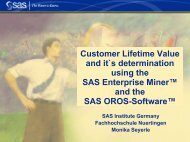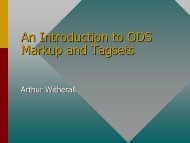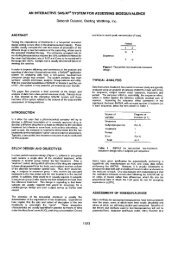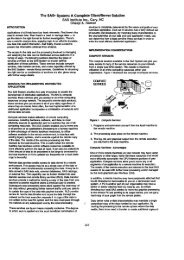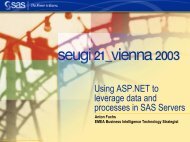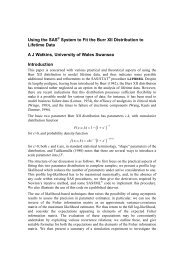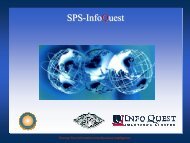Balanced Scorecard ING BANK - sasCommunity.org
Balanced Scorecard ING BANK - sasCommunity.org
Balanced Scorecard ING BANK - sasCommunity.org
Create successful ePaper yourself
Turn your PDF publications into a flip-book with our unique Google optimized e-Paper software.
Popko de Vlugt & Kees Timmers
Balancing functions &<br />
techniques<br />
<strong>Balanced</strong> <strong>Scorecard</strong> <strong>ING</strong> <strong>BANK</strong>
Agenda<br />
• Introduction<br />
• Challenges and strategy<br />
• Implementation of the <strong>Balanced</strong> <strong>Scorecard</strong><br />
• Balancing Techniques
<strong>ING</strong> Group<br />
• Global financial institution of Dutch origin<br />
• In 60 countries with over 80,000 employees<br />
• Total assets over 482 bln (4thq. 1999)<br />
• Offers integrated financial services to retail, corporate<br />
and institutional clients<br />
• Through many divisions operating under own label<br />
• <strong>ING</strong> carefully balances ineterests of its customers,<br />
shareholders and employees
Seven years results <strong>ING</strong> (in Euro’s)<br />
7,000<br />
6,000<br />
5,000<br />
4,000<br />
3,000<br />
2,000<br />
1,000<br />
0,000<br />
1992 1993 1994 1995 1996 1997 1998 1999<br />
Result before taxation<br />
Net profit
Organisational structure<br />
(as of 1 Januari 2000)<br />
Supervisory board<br />
<strong>ING</strong> Group<br />
Executive board<br />
<strong>ING</strong> Group<br />
<strong>ING</strong> Corporate & Investment Banking<br />
<strong>ING</strong> Direct<br />
<strong>ING</strong> Asset Management<br />
e-Business<br />
<strong>ING</strong> Europe <strong>ING</strong> Americas <strong>ING</strong> Asia/Pacific
Strategic challenges<br />
• Strategic challenges<br />
• Higher demands of customer<br />
• More options due to technology, new players<br />
• More difficult to meet financial requirements<br />
…Necessitates more focus on activities<br />
• Alignment of strategy and <strong>org</strong>anisation
Strategy<br />
• Customer partnership<br />
• Client chracteristics ordening principle of <strong>org</strong>anisation<br />
…Different segments, with different demands
<strong>Balanced</strong> <strong>Scorecard</strong>: Users & usage<br />
• Primary users: Mid-level sales management in<br />
branches as well as headquarters departments<br />
• Management attitude<br />
• Self-management and communication, instead of control<br />
• Uniformity of goals, different ways to achieve them<br />
• Offer more than financial information<br />
• Is reprospective<br />
• Is short-term focused<br />
• Has little explanatory power
<strong>Balanced</strong> <strong>Scorecard</strong>: Distribution<br />
• Via Intranet<br />
• Figures and analyses by slice and dice<br />
• Benchmarking<br />
• Step by step implementation<br />
• Use of tools has to set itself
Lessons learned<br />
• It takes a lot of time, persuasion and matrix movements<br />
• Communication: workshops, intranet, leaflets, etc.<br />
• In line with users learning curve<br />
• Keep it simple<br />
• Define comprehensive phases<br />
• Clearly environment: quality assurance, planning & budgetting,<br />
audits<br />
• Mobilize senior management in reporting demands
Hurdles<br />
• Budget discussions, how to manage the expectations<br />
• BSc concept is innovative, play save in technicals<br />
• Users objections<br />
• Give me more, woth this I can’t work<br />
• Give me basis information, then I’ll look at strategics, BSc
How has the BSc affected decisions<br />
• Planning & budgetting in 4 perspectives<br />
• Commercial floor level<br />
• Steering in activities<br />
• Management level<br />
• Reporting in 4 levels<br />
• Investment/project decisions<br />
• Turn-around management
Next ambitions<br />
• In 3 years 90% of personnel has a BSc<br />
• Embedded in management information concept:<br />
• Functional: get what you need<br />
• Technical: portals
To be continued<br />
• Kees Timmers
Balancing techniques<br />
• eNiklas (Netherlands) B.V.<br />
• Present situation<br />
• (near)Future situtation<br />
• Next phase<br />
• Demo
eNiklas<br />
• A new e-company<br />
• eSolutions<br />
• Analytical-, Business- & IT consulting<br />
To help companies explore their potential to<br />
grow<br />
www.eNiklas.com
Present situation<br />
• One-level of information<br />
• Web-publishing<br />
• SAS/Base only<br />
• A lot of SAS programs (Base,<br />
SCL & Macro’s)<br />
• Data on UNIX, Web-pages on<br />
NT<br />
• Not flexible enough<br />
• Not very interactive<br />
• Completely tailor made
Goals<br />
• Flexible BSc-tool<br />
• <strong>Scorecard</strong> for each segment<br />
• <strong>Scorecard</strong> for each <strong>org</strong>anisational level<br />
• <strong>Scorecard</strong> for more <strong>ING</strong> companies<br />
• Data-driven back-end<br />
• Interactive front-end<br />
• With the use of standard tools<br />
• Iterative approach
Near-future situation<br />
• SAS/Version 8<br />
• Metabase<br />
• UNIX server<br />
•Warehouse<br />
•SAS/IntrNet<br />
•Webserver<br />
• Combining tailor-made & SAS<br />
V8 standard tools<br />
•Using the MDDB & SAS/IntrNet<br />
MDDB Report Viewer<br />
• One tool for simple & complex<br />
reporting<br />
Metabase
Next phase<br />
• Using BSc as a web-portal<br />
• Strategic Vision<br />
• Publish & subscribe<br />
• Messaging
Demonstration




